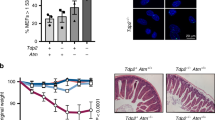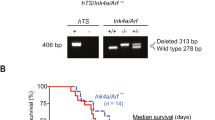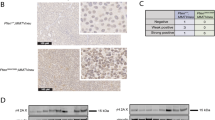Abstract
Ataxia-telangiectasia is characterized by radiosensitivity, genome instability and predisposition to cancer1,2. Heterozygous carriers of ATM, the gene defective in ataxia-telangiectasia, have a higher than normal risk of developing breast and other cancers3,4,5,6. We demonstrate here that Atm 'knock-in' (Atm-ΔSRI) heterozygous mice harboring an in-frame deletion corresponding to the human 7636del9 mutation show an increased susceptibility to developing tumors. In contrast, no tumors are observed in Atm knockout (Atm+/−) heterozygous mice. In parallel, we report the appearance of tumors in 6 humans from 12 families who are heterozygous for the 7636del9 mutation. Expression of ATM cDNA containing the 7636del9 mutation had a dominant-negative effect in control cells, inhibiting radiation-induced ATM kinase activity in vivo and in vitro. This reduces the survival of these cells after radiation exposure and enhances the level of radiation-induced chromosomal aberrations. These results show for the first time that mouse carriers of a mutated Atm that are capable of expressing Atm have a higher risk of cancer. This finding provides further support for cancer predisposition in human ataxia-telangiectasia carriers.
This is a preview of subscription content, access via your institution
Access options
Subscribe to this journal
Receive 12 print issues and online access
$209.00 per year
only $17.42 per issue
Buy this article
- Purchase on Springer Link
- Instant access to full article PDF
Prices may be subject to local taxes which are calculated during checkout




Similar content being viewed by others
References
Lavin, M.F. & Shiloh, Y. The genetic defect in ataxia-telangiectasia. Annu. Rev. Immunol. 15, 177–202 (1997).
Rotman, G. & Shiloh, Y. ATM: a mediator of multiple responses to genotoxic stress. Oncogene 18, 6135–6144 (1999).
Swift, M., Morrell, D., Massey, R.B. & Chase, C.L. Incidence of cancer in 161 families affected by ataxia-telangiectasia. N. Engl. J. Med. 325, 1831–1836 (1991).
Inskip, H.M., Kinlen, L.J., Taylor, A.M., Woods, C.G. & Arlett, C.F. Risk of breast cancer and other cancers in heterozygotes for ataxia-telangiectasia. Br. J. Cancer 79, 1304–1307 (1999).
Olsen, J.H. et al. Cancer in patients with ataxia-telangiectasia and in their relatives in the Nordic countries. J. Natl Cancer Inst. 93, 121–127 (2001).
Athma, P., Rappaport, R. & Swift, M. Molecular genotyping shows that ataxia-telangiectasia heterozygotes are predisposed to breast cancer. Cancer Genet. Cytogenet. 92, 130–134 (1996).
Fitzgerald, M.G. et al. Heterozygous ATM mutations do not contribute to early onset of breast cancer. Nature Genet. 15, 307–310 (1997).
Izatt, L. et al. Identification of germline missense mutations and rare allelic variants in the ATM gene in early-onset breast cancer. Genes Chromosomes Cancer 26, 286–294 (1999).
Teraoka, S.N. et al. Increased frequency of ATM mutations in breast carcinoma patients with early onset disease and positive family history. Cancer 92, 479–487 (2001).
Dörk, T. et al. Spectrum of ATM gene mutations in a hospital-based series of unselected breast cancer patients. Cancer Res. 61, 7608–7615 (2001).
Spring, K. et al. Atm knock-in mice harboring an in-frame deletion corresponding to the human ATM 7636del9 common mutation exhibit a variant phenotype. Cancer Res. 61, 4561–4568 (2001).
Barlow, C. et al. Atm-deficient mice: a paradigm of ataxia telangiectasia. Cell 86, 159–171 (1996).
Elson, A. et al. Pleiotropic defects in ataxia-telangiectasia protein-deficient mice. Proc. Natl Acad. Sci. USA 93, 13084–13089 (1996).
Herzog, K.H., Chong, M.J., Kapsetaki, M., Morgan, J.I. & McKinnon, P.J. Requirement for Atm in ionizing radiation-induced cell death in the developing central nervous system. Science 280, 1089–1091 (1998).
Savitsky, K. et al. A single ataxia-telangiectasia gene with a product similar to PI-3 kinase. Science 268, 1749–1753 (1995).
Li, A. & Swift, M. Mutations of the ataxia-telangiectasia locus and clinical phenotypes of ataxia-telangiectasia patients. Am. J. Med. Genet. 92, 170–177 (2000).
Vorechovsky, I. et al. ATM mutations in cancer families. Cancer Res. 56, 4130–4133 (1996).
Chen, P.C., Lavin, M.F., Kidson, C. & Moss, D. Identification of ataxia-telangiectasia heterozygotes, a cancer prone population. Nature 274, 484–486 (1978).
Paterson, M.C., MacFarlane, S.J., Gentner, N. & Smith, B.P. Cellular hypersensitivity to chronic γ-radiation in cultured fibroblasts from ataxia-telangiectasia heterozygotes. In Ataxia-telangiectasia: Genetics, Neuropathology and Immunology of a Degenerative Disease of Childhood (eds Gatti, R.A. & Swift, M.) 73–87 (Alan R. Liss, New York, 1985).
Zhang, N. et al. Isolation of full-length ATM cDNA and correction of the ataxia-telangiectasia cellular phenotype. Proc. Natl Acad. Sci. USA 94, 8021–8026 (1997).
Chenevix-Trench, G. et al. Dominant negative ATM mutations in breast cancer families. J. Natl Cancer Inst. 94, 205–215 (2002).
Larson, G. et al. An allelic variant at the ATM locus is implicated in breast cancer susceptibility. Genetic Testing 1, 165–170 (1998).
Becker-Catania, S.G. et al. Ataxia-telangiectasia: phenotype/genotype studies of ATM protein expression, mutations and radiosensitivity. Mol. Gen. Metab. 70, 122–133 (2000).
Gueven, N. et al. Epidermal growth factor sensitizes cells to ionizing radiation by down-regulating protein mutated in ataxia-telangiectasia. J. Biol. Chem. 276, 8884–8891 (2001).
Gilad, S. et al. Predominance of null mutations in ataxia-telangiectasia. Hum. Mol. Genet. 5, 433–439 (1996).
Stewart, G.S. et al. Residual ATM protein function in cells from ataxia telangiectasia patients 5762ins137 and 7271T→G mutations, showing a less severe phenotype. J. Biol. Chem. 276, 30133–30141 (2001).
Lim, D.S. et al. ATM phosphorylates p95/nbs1 in an S-phase checkpoint pathway. Nature 404, 613–617 (2000).
Scott S.P. et al. Missense mutations but not allelic variants alter the function of ATM by dominant interference in patients with breast cancer. Proc. Natl Acad. Sci. USA 99, 925–930 (2002).
Barlow, C., Eckhaus, M.A., Schaffer, A.A. & Wynshaw-Boris, A. Atm haploinsufficiency results in increased sensitivity to sublethal doses of ionizing radiation in mice. Nature Genet. 21, 359–360 (1999).
Canman, C.E. et al. Activation of the ATM kinase by ionizing radiation and phosphorylation of p53. Science 281, 1677–1679 (1998).
Acknowledgements
We thank the Australian National Health and Medical Research Council, the Ataxia-Telangiectasia Research Foundation (Los Angeles) and the Ataxia-Telangiectasia Children's Project (Florida) for support. Thanks to A. Farrell for technical support and T. Laing for typing the manuscript. P.J.M. acknowledges support from the NIH and the American Lebanese and Syrian Associated Charities (ALSAC) of St. Jude Children's Research Hospital. M.S. acknowledges support from the NIH.
Author information
Authors and Affiliations
Corresponding author
Ethics declarations
Competing interests
The authors declare no competing financial interests.
Supplementary information
Rights and permissions
About this article
Cite this article
Spring, K., Ahangari, F., Scott, S. et al. Mice heterozygous for mutation in Atm, the gene involved in ataxia-telangiectasia, have heightened susceptibility to cancer. Nat Genet 32, 185–190 (2002). https://doi.org/10.1038/ng958
Received:
Accepted:
Published:
Issue Date:
DOI: https://doi.org/10.1038/ng958
This article is cited by
-
Cancer risks associated with heterozygous ATM loss of function and missense pathogenic variants based on multigene panel analysis
Breast Cancer Research and Treatment (2022)
-
ATM, ATR and DNA-PKcs kinases—the lessons from the mouse models: inhibition ≠ deletion
Cell & Bioscience (2020)
-
ATM, DNA-PKcs and ATR: shaping development through the regulation of the DNA damage responses
Genome Instability & Disease (2020)
-
Inflammation, a significant player of Ataxia–Telangiectasia pathogenesis?
Inflammation Research (2018)
-
Evaluation of ATM heterozygous mutations underlying individual differences in radiosensitivity using genome editing in human cultured cells
Scientific Reports (2017)



